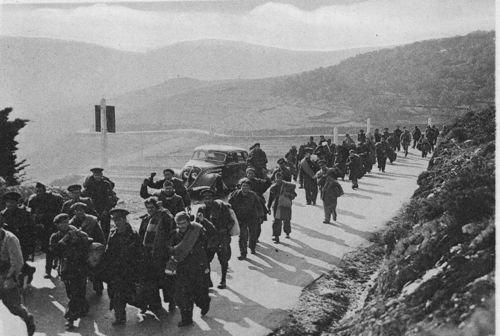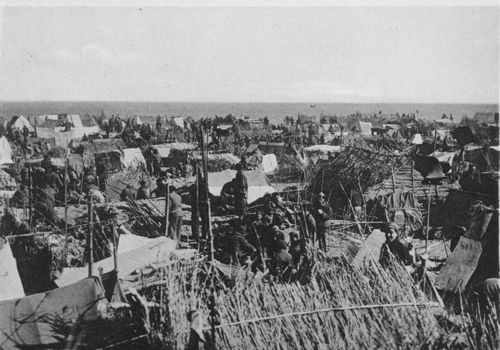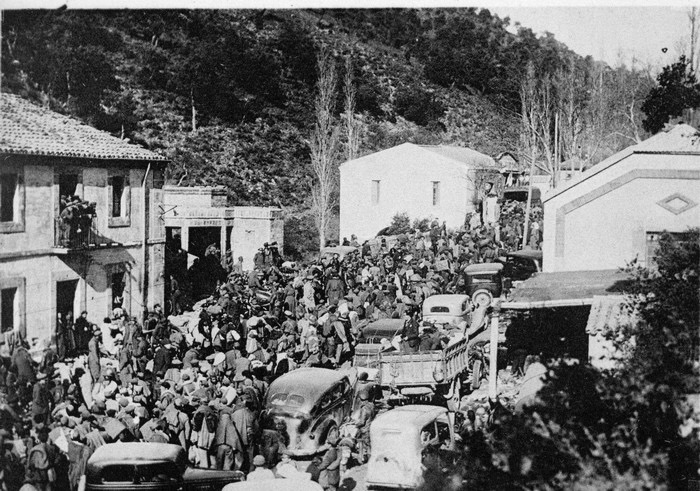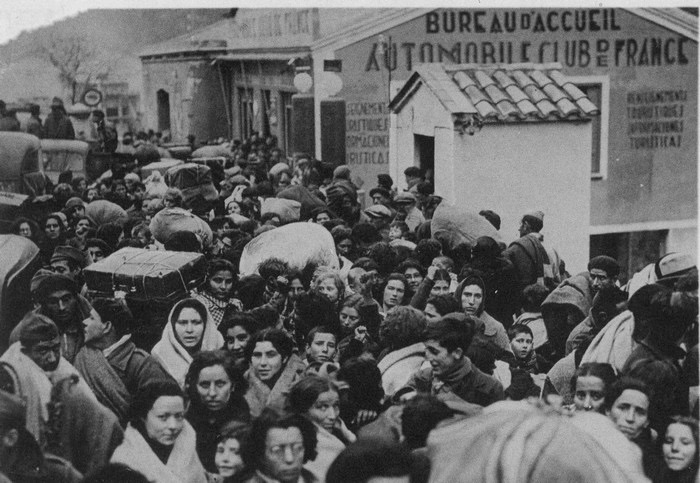La Retirada
In late January/early February 1939 nearly half a million Spanish civilians and soldiers fled to France. The word Retirada (Spanish for Retreat) was adopted by historians to signify this exodus, which was the biggest single influx of refugees ever known in France.
Foreign ‘Undesirables’

The French authorities were unprepared and hostile.
Some women and children were allowed in on that same night. Between 5 and 9 February all the “Reds” (so-dubbed) were admitted as “foreign undesirables”.
This label meant they could be imprisoned legally.
Women and children were initially sent to accommodation centres and about 60,000 men were herded into internment camps on the beach at Argelès-sur-Mer. Their only welcome was barbed wire fences, ’Gardes Mobiles’ (a special branch of the gendarmerie) and brutal Senegalese troops.
These camps had no protection from freezing temperatures and biting winds apart from a few improvised flimsy shacks. Most men slept in holes dug in the ground. There was no water, no sanitation and scarcely any food. According to one of the world’s finest-ever photojournalists Robert Capa, “for sport many mounted and armed French guards beat up dying men … One night in February seventeen had died of exposure and were buried where they lay.”
Similar internment camps soon followed at St Cyprien and Le Barcarès. Unspeakable squalor. An estimated 15,000 died of dysentery and related diseases. Graphic words and images of the rat-infested conditions there do exist if you want to search on Google but be warned! – you will need a strong stomach.
The exiles (the men separated from the women and children) were later moved to designated “concentration camps” spread over the South of France: to Bram (west of Carcassonne), Agde, Vernet in the Ariège – and Rivesaltes where they were to be joined after the German occupation (from May 1940) by other undesirables including East European Jews and “gypsies”.

A few Republicans were taken in by mercifully kind French Catalans. Some managed to emigrate to South America and elsewhere. Others went back to Spain, voluntarily or otherwise – often to suffer persecution, prison or death. The majority of exiles, however, were conscripted into “Squads of Foreign Workers” (unpaid) or the Foreign Legion.
After the German occupation, the repression of the exiles intensified and thousands of them were exterminated in the Nazi gas chambers – especially at Mauthausen.
Many surviving exiles, however, in spite of their treatment, volunteered to join the French Resistance and contributed substantially as “Guerilleros Espagnols” to the Liberation from 6 June onwards in 1944. On 15 March 1945 the exiles were finally granted the official status of Political Refugees.
A third of the Languedoc-Roussillon’s present-day population are descendants of these Spanish refugees.

MARIA GENOVER – A STORY OF INDOMITABLE COURAGE
Figueres in Spanish Catalunya – about 25 kilometres south of the French border – was the last Republican stronghold and seat of government after the fall of Barcelona. In late January/early February 1939 it was bombed relentlessly, leading to hundreds of casualties and endless processions of fugitives making for the French border.
One such fugitive was Emilio Genover who ended up in the camp at Argelès. His wife Maria was left behind to bring up alone her three children with no money and scarcely any food. At the age of 99 she recorded her story of how war broke out on a peaceful Sunday afternoon. She and her family spent years living in terrified poverty under a hail of bombs and running from one makeshift shelter to the other. They were penniless and often starving. Fortunately her story has a happy ending. She and her children were eventually reunited with Emilio in France, where they made their home.
Here is a transcript of part of an interview with Senora Genover, her own story, taken from a recording she made in 2004, which formed part of Elmediator’s exhibition in Perpignan, Retirada 1939-2009: Paroles d’Images.
The beginning:
“…. the children were bathing outside on the terrace – and my son said “Mama! a plane is passing over and it has dropped something!” It was a Sunday when people were getting up from their meal and strolling in the park – they killed them all – that’s horrible isn’t it ? ……. a man passed and said “everything is destroyed – there are guts hanging from the trees… everyone is dead… and now they are coming !” I was so frightened I couldn’t think straight… “
Later in their flight, she and the children were looking for a shelter and found a farm:
“…. the owner said “We are full – all I have available is the pig sty.” How well I slept that night! The next day we had to leave …… on the way we heard planes dropping bombs. “There is a crater on the roadside – let’s go and hide there!” – just beside a barn we finally hid ourselves and a bomb fell in the crater… “
Poverty and near-starvation
“…….. there were times when the children said “You’ve made too little to eat! Can I lick the casserole?” little Moïse when he left school – he hurried to get back home where there was a cupboard to which I had the key hanging from my neck – for it contained the food – he unfastened the doors – I have no idea how – and he took some bread and other things and when I would open it, I had no idea why there was no more bread!”
After several years of this misery, came the final flight from Spain. Penniless and trying in vain to buy food, Maria Genover met someone who told her that there was a big parcel waiting for her at the shoeshop. It was money sent by her husband Emilio so they could join him in France:
“So I paid a border escort … without carrying very much we took a lot of time to cross the frontier. There was as much danger on one side as on the other… we were tired – all night we walked without even stopping for a weewee ……. We could manage no more – we found ourselves in a farm with other folk and there was someone there waiting for his family ’Ah ! Emilio I know him I am going to Perpignan – I will tell him you are here.’”
And so this family, unlike many others, was eventually re-united in France.
Madame Genover died a few months after her 100 birthday.
Take a walk in Argelès in the footsteps of the Retirada on the ’circuit de la Mémoire
- Stage 1 : Le monolithe (rue des Dunes – Beach)
Unveiled in 1999, this monument marks the entrance to the camp in Argelès-sur-Mer and honours the Spanish Republicans imprisoned there from February 1939. - Stage 2 : la plaque nord (near the parking de la Marenda – Beach) Marks out the borders of the former camp.
- Stage 3 : le cimetière des Espagnols (avenue de la Retirada) From the opening of the camp in February 1939, many deaths were recorded. A private land owner handed over a plot of land to the Mairie to be used as the camp cemetery. It was later flooded and destroyed by the terrible floods of 1940. Today, all that is left is a stone put up in the 1950s, engraved with the names of those who died in the camp during their internment, and a tree dedicated to the 70 children aged under 10 who also died in the camp.
- Stage 4 : Le Mémorial du camp d’Argelès-sur-Mer. Small museum (26 Avenue de la Libération, Argelès Village)




